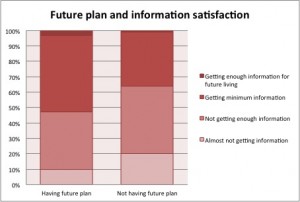Store Owners with Vision Seek Rapid Recovery
Temporary shopping streets are opening one after another in the disaster-affected areas. The scale of these streets vary from a few stores to more than 50, but the will to restore the local community is a common one.

Entrance to Rikuzentakata Mirai Shopping Street
With such will, a temporary shopping street called “Rikuzentakata Mirai Shopping Street” (mirai meaning future in Japanese) is up and running before its official opening. Rikuzentakata is a coastal city in Iwate Prefecture where some 1,700 people lost their lives and more than 3,000 homes and apartments were completely destroyed by the tsunami. Four stores are currently open for business, and Mr Osamu Ogasawara, who runs one of the first two stores to open – “Fashion Rope Tokyo” – lost in the tsunami his store which had been open for 52 years. He also lost his storehouse and home, but decided to re-build his store in the local community, saying “if it can be done in the Rikuzentakata I’ve lived in, then I will try my best here.” By co-operating with store owners affected by the disaster, appealing for nationwide support via the internet, and other means, he managed to re-open the business on February 14.

Mr and Mrs Ogasawara outside the clothing store they run
Mr Ogasawara says with ambition: “I hope this shopping street becomes the heart of shopping in Rikuzentakata.” He also wants to make it a place where residents can come together and relax, and is full of dreams for the streets’ future. A workshop was held in Rikuzentakata Mirai Shopping Street to decide on a vision for restoration of the shopping streets, and was attended by a specialist team led by Associate Professor Hideki Koizumi of the Urban Land Use Planning Unit at the Department of Urban Engineering, Graduate School of Engineering, University of Tokyo. Store owners gathered and exchanged opinions in a frank manner, and team staff will assess needs. Mr Ogasawara is enthusiastic and says he hopes to make good use of this kind of specialist support.
Lively Shopping Streets at the Center of Local Communities
Delays in building and installation are among the serious problems facing temporary shopping streets such as Rikuzentakata Mirai Shopping Street. Associate Professor Koizumi points out: “Even though they are temporary shopping streets, more than a year has passed and yet many parts are incomplete. Owners cannot have prospects until their stores are rebuilt. If too much time passes the owners will give up on re-opening their businesses there.” Indeed, Rikuzentakata Mirai Shopping Street did not open until February this year, almost one year on since the disaster. The official opening is scheduled for this autumn, but given the delays in procedure and building, it will possibly be later than that.
There is an eight-year business recovery plan for Rikuzentakata City – a three-year period of repairs which started in 2011, followed by a five-year period of development starting in 2014 – and in which there are six objectives including building “a safe town well-prepared against natural disasters” and “a comfortable and attractive town.” Mr Ogasawara voices his unease with the plan however, which spans some 57 pages, when he asks the question: “Do we have to run our stores in temporary facilities for eight whole years?” According to the current plan, a rapid restoration of permanent shopping streets seems difficult as raising the level of low-lying areas will precede construction of the shopping streets.
In regard to this Associate Professor Koizumi says: “Places like Rikuzentakata Mirai Shopping Street which are determined and are attempting to build new shopping streets should be assisted separately. If a broad framework for urban planning is solid and clear, in the end there shouldn’t be a big discrepancy.”
Keeping in mind the move to permanent facilities is also of importance when setting up temporary shopping streets. If the location is appropriate and a community comes together smoothly, the work required when re-building shopping streets from scratch can be reduced. In addition, a more stable, long-lasting shopping street can be expected. In some cases a move to a permanent location ahead of schedule may be possible. Pursuing a uniform or standardized restoration “for the sake of fairness” or the like cannot be said to be the best policy.
What is important for temporary shopping streets are flexibility and promptness after meeting the conditions of a broad framework. In order for the shopping streets to realize a sustainable level of business promptly and to function as the core of the community, specialists need to create opportunities for dialogue when approaching the communities. We hope that the determination of store owners who have decided to take the difficult path of re-building local communities results in success.
(Translated by Nate Hill)
Tweet




